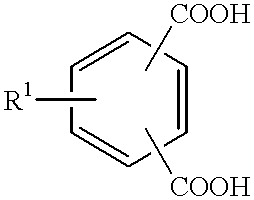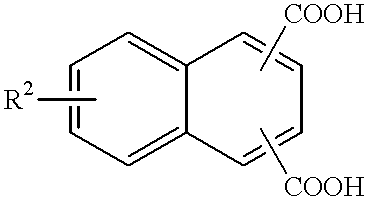Low viscosity polyester-polyols and polyurethane foams prepared therefrom
a polyester polymer and low viscosity technology, applied in the preparation of isocyanic acid derivatives, organic chemistry, carbamic acid derivatives, etc., can solve the problems of difficult to adjust the viscosity and melting point of the prepolymer to a level, and the proposal has some problems
- Summary
- Abstract
- Description
- Claims
- Application Information
AI Technical Summary
Benefits of technology
Problems solved by technology
Method used
Image
Examples
production examples 1 to 3
Preparation of Polyol Components A to C
There were mixed together 40 parts of Polyester-Polyol A, B or C obtained in Preparation Example 1, 2 or 3 as shown in Table 2, 60 parts of a polyester-polyol [starting monomers: ethylene glycol, 1,4-butanediol and adipic acid; ethylene glycol / 1,4-butanediol (weight ratio)=1 / 1; number-average molecular weight: 1,300], 11 parts of ethylene glycol as a chain extender, 1.05 parts of water as a blowing agent, 0.8 parts of triethylenediamine as a catalyst and 1 part of a silicone cell regulator, and agitated with heating to a temperature of 60.degree. C., to give Polyol Components A to C.
As the physical properties of Polyol Components A to C, acid value, hydroxyl value and viscosity were determined in the same manner as in Preparation Example 1, and water content was determined in accordance with JIS K 0068. The results are shown in Table 2.
production example 4
Preparation of Polyol Component D
There were mixed together 40 parts of a polyester-polyol (ethylene-1,4-butanediol adipate copolymer; number-average molecular weight: 2,200), 60 parts of a polyester-polyol (ethylene-1,4-butanediol adipate copolymer; number-average molecular weight: 1,300), 11 parts of ethylene glycol as a chain extender, 1.05 parts of water as a blowing agent, 0.8 parts of triethylenediamine as a catalyst and 1 part of a silicone cell regulator, and agitated with heating to a temperature of 60.degree. C., to give Polyol Component D.
The physical properties of Polyol Component D were determined in the same manner as in Production Example 1. The results are shown in Table 2.
examples 1 to 3
An automated blending injection foaming machine (Model MU-203S, No. 6-018, manufactured by Polyurethane Engineering Co., Ltd.) was charged with each of Polyol Components A to C obtained in Production Examples 1 to 3 and an isocyanate prepolymer (trade name: "EDDYFOAM B-2009", manufactured by Kao Corporation; NCO %: 18.5%), and the resulting mixture was allowed to be foamed under the following molding conditions to yield a polyurethane foam sheet of 10 mm.times.100 mm.times.300 mm. The Polyol Component used in each of Examples is listed in Table 3.
[Molding Conditions]
Isocyanate index: 100 to 103
Mixing temperature: Each temperature of the isocyanate prepolymer and polyol components being adjusted to 35.degree. to 45.degree. C.
Reaction time: Cream time: 5 to 10 seconds Silk time: 15 to 25 seconds Rise time: 35 to 60 seconds Tack free time: 30 to 55 seconds Release time from mold: 4.5 to 5.5 minutes
Mold: Temperature of mold: 45.degree. to 55.degree. C. Mold release agent: silicone and w...
PUM
| Property | Measurement | Unit |
|---|---|---|
| viscosity | aaaaa | aaaaa |
| molar ratio | aaaaa | aaaaa |
| temperature | aaaaa | aaaaa |
Abstract
Description
Claims
Application Information
 Login to View More
Login to View More - R&D
- Intellectual Property
- Life Sciences
- Materials
- Tech Scout
- Unparalleled Data Quality
- Higher Quality Content
- 60% Fewer Hallucinations
Browse by: Latest US Patents, China's latest patents, Technical Efficacy Thesaurus, Application Domain, Technology Topic, Popular Technical Reports.
© 2025 PatSnap. All rights reserved.Legal|Privacy policy|Modern Slavery Act Transparency Statement|Sitemap|About US| Contact US: help@patsnap.com


